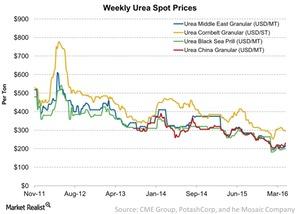Tracking Urea Price Movement during the Week Ending April 22
In 2013, about 54% of global ammonia was upgraded to urea, according to FERTECON. But urea prices have rebounded from their lows at the beginning of 2016.
Dec. 4 2020, Updated 10:53 a.m. ET

Urea
In 2013, about 54% of global ammonia was upgraded to urea, according to FERTECON. Urea prices have rebounded from their lows at the beginning of 2016, especially in the US Corn Belt region, implying that demand has picked up.
Granular urea prices
While ammonia prices in the Corn Belt moved sideways, granular urea prices in the same region declined to $267 per metric ton FOB (free on board), or $295 per short ton, from $272 per metric ton, or $300 per short ton, in the week ending April 22. This represents a decline of 1.6% from one week earlier. YoY (year-over-year), prices in the Corn Belt are now down by 21%.
Meanwhile, urea prices in China inched up to $230 per metric ton, as compared to $215 per metric ton in the previous week. Urea in China fell by 13% YoY as compared to $265 per metric ton in the same week last year.
The price of urea in the Middle East also inched up, reaching $215 per metric ton in the week ending April 22. This compares to $208 per metric ton one week previously. Urea prices dropped by 22% YoY in the Middle East.
Prill urea prices
Prill urea prices from the Black Sea region were unchanged week-over-week, at $200 per metric ton in the week ending April 22. Prill urea prices from this region declined by 23% YoY.
Urea prices in China affect companies such as CF Industries (CF), CVR Partners (UAN), PotashCorp (POT), and Agrium (AGU). Rising prices also affect the iShares US Basic Materials ETF (IYM). IYM invests ~48% in chemical companies.
Now let’s look at key input costs for nitrogen fertilizers.
